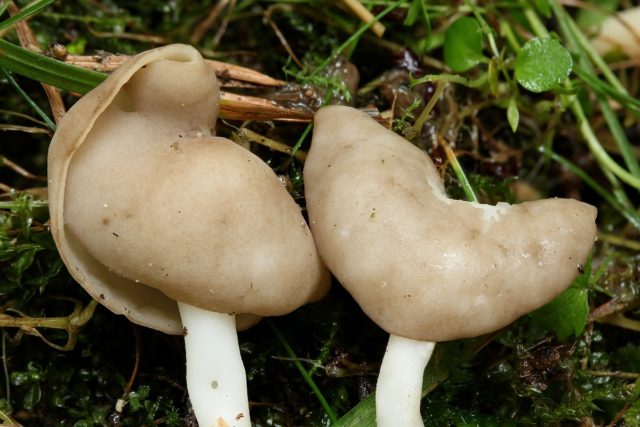Content
Helvella curly, curly lobe or Helvella crispa is a mushroom of the Helwell family. Rare, autumn fruiting. The nutritional value is low, the species belongs to the last fourth group.

The lobe has an unusual structure of the leg and cap.
What do curly paddles look like?
The mushroom is medium in size, growing up to 10-12 cm in height without a definite shape of the upper part. A marsupial species, spores are formed not on the surface of the cap, but in the fruiting body.
External characteristic:
- Apothecium of irregular saddle shape, divided into several lobes.
- The upper part of young mushrooms with concave, relatively smooth edges, over time, the cap straightens, becomes shapeless, the edges are hanging wavy or curly.
- The cap is loosely attached to the stem in the center, the surface is folded, small tuberous or wrinkled. The color is monochromatic, light cream or beige. The protective film is smooth matte.
- The lower part with a fine, sparse edge, one tone darker than the upper surface.
- The pulp is thin, fragile, light beige with a pleasant smell.
- The leg is often straight, can be curved in the upper part, fusiform, thickened at the base, 3 cm wide.
- The surface is ribbed with deep grooves, longitudinal stripes covering the underside of the cap.
- The color is white or light ash.
The structure of the stem is hollow, fibrous and brittle. In overripe specimens, it is tough.

The edges of the cap may be strongly raised or clearly concave
Where curly lobes grow
The species is not widespread, it is rare. In Russia, the main cluster is in the European part. It grows in open areas: forest glades, glades, near roads. The mycelium is located among low grass, coniferous or leaf litter. Occurs singly or in small groups from the end of August in all types of forests.
Is it possible to eat curly lobes
The species is rare and completely unexplored, but many specimens contain muscarine in the fruiting body. A natural alkaloid is a part of many poisonous mushrooms and causes varying degrees of intoxication. Partially decomposes on drying or heat treatment.
Due to its rarity, no cases of poisoning with curly lobe have been recorded, and besides, it is not used in large quantities. Fruiting bodies with low nutritional value are referred to the conditionally edible group. Use is possible only after boiling. In the autumn, other types of edible mushrooms bear fruit, so it is better not to take the lobe.
False doubles
False twins of helwella curly include elastic lobe. The mushroom is quite common. Fruiting profusely from mid-July. It is found in all types of young and old forests, prefers well-humid shaded areas. Belongs to the fourth category, conditionally edible species. The fruiting body is tasteless and odorless.

The vane's cap is elastic with smooth edges and a light brown surface
Collection rules
The main harvesting time for the curly lobe is mid-September.It is not recommended to take crops in an environmentally unfavorable zone: near chemical plants, gas stations, along the sides of highways, city dumps.
Conclusion
Lobules curly without taste and pronounced odor, is not of gastronomic interest. The species is classified as conditionally edible. Fruiting in autumn, use is possible only after boiling.








